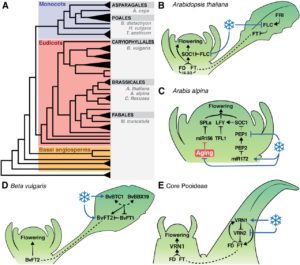Update: Winter Memory throughout the Plant Kingdom: Different Paths to Flowering
 Plants have evolved a variety of mechanisms to synchronize flowering with their environment to optimize reproductive success. Many species flower in spring when the photoperiod increases and the ambient temperatures become warmer. Winter annuals and biennials have evolved repression mechanisms that prevent the transition to reproductive development in the fall. These repressive processes can be overcome by the prolonged cold of winter through a process known as vernalization. The memory of the past winter is sometimes stored by epigenetic chromatin remodeling processes that provide competence to flower, and plants usually require additional inductive signals to flower in spring. The requirement for vernalization is widespread within groups of plants adapted to temperate climates; however, the genetic and biochemical frameworks controlling the response are distinct in different groups of plants, suggesting independent evolutionary origins. Here, we compare and contrast the vernalization pathways in different families of plants.
Plants have evolved a variety of mechanisms to synchronize flowering with their environment to optimize reproductive success. Many species flower in spring when the photoperiod increases and the ambient temperatures become warmer. Winter annuals and biennials have evolved repression mechanisms that prevent the transition to reproductive development in the fall. These repressive processes can be overcome by the prolonged cold of winter through a process known as vernalization. The memory of the past winter is sometimes stored by epigenetic chromatin remodeling processes that provide competence to flower, and plants usually require additional inductive signals to flower in spring. The requirement for vernalization is widespread within groups of plants adapted to temperate climates; however, the genetic and biochemical frameworks controlling the response are distinct in different groups of plants, suggesting independent evolutionary origins. Here, we compare and contrast the vernalization pathways in different families of plants.
Bouché, F., Woods, D.P. and Amasino, R.M. (2017). Winter Memory throughout the Plant Kingdom: Different Paths to Flowering. Plant Physiology. 173: 27-35.




Leave a Reply
Want to join the discussion?Feel free to contribute!